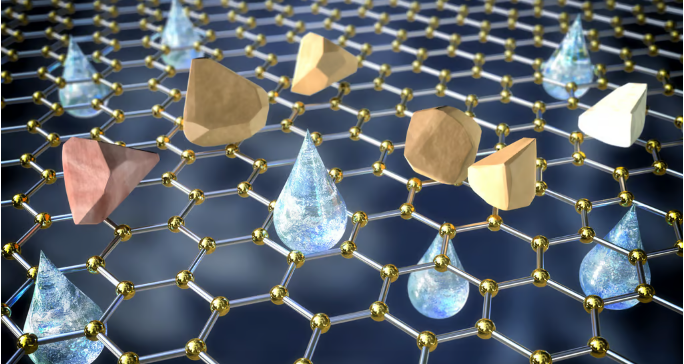Ultrananaotech, ULTRANANOTECH
Graphene Oxide for Water Treatment: Transforming the Future of Water Purification
Introduction
Water scarcity and water contamination are some of the most pressing environmental challenges faced globally. As the world continues to grapple with these issues, innovative technologies and materials are being explored to ensure clean and accessible water for all. Among these solutions, graphene oxide (GO) has emerged as a promising material due to its unique properties, particularly its potential for water treatment. This blog explores the significance of graphene oxide dispersion in water treatment and how it could revolutionize water purification processes.
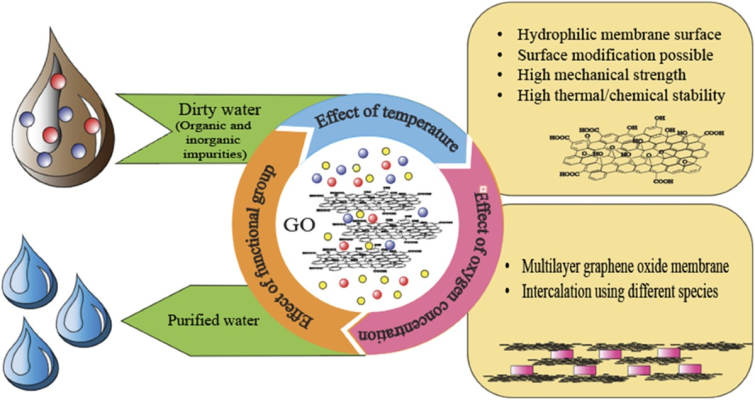
Fig: Graphene Oxide based membranes for water desalination & purification (Source: Springer Materials)
What is Graphene Oxide?
Graphene oxide is a derivative of graphene, a two-dimensional sheet of carbon atoms arranged in a hexagonal lattice. What sets graphene oxide apart is the introduction of oxygen-containing functional groups, such as epoxides, hydroxyls, and carboxyls, on its surface. These oxygen groups make graphene oxide more hydrophilic (water-attracting), unlike pure graphene, which is hydrophobic.
This increased affinity for water, combined with the material’s high surface area and excellent mechanical properties, gives graphene oxide exceptional potential for applications in water treatment.
Why Graphene Oxide for Water Treatment?
- High Surface Area
Graphene oxide has an exceptionally high surface area (around 2630 m²/g), which allows it to adsorb large quantities of contaminants. This characteristic makes GO ideal for removing pollutants like heavy metals, oils, and organic compounds from water. - Enhanced Adsorption Capacity
The oxygenated functional groups on graphene oxide increases its ability to adsorb contaminants. GO’s surface can easily interact with various pollutants such as heavy metals (lead, mercury, arsenic), oils, dyes, and even viruses, facilitating their removal from water. - Antibacterial Properties
GO has been found to possess antibacterial properties, making it highly effective in killing or neutralizing harmful bacteria in water. Its sharp edges can physically damage the cell membranes of bacteria, while its oxygen groups can disrupt microbial function. This makes GO an excellent choice for purifying water that contains harmful pathogens. - Selective Filtration
Graphene oxide can form membranes that exhibit selective permeability due to their sieve like morphology, meaning they can filter out contaminants while allowing clean water to pass through. These membranes are capable of separating both small and large molecules with high precision, making them highly effective in filtration processes, such as desalination or removing pollutants from wastewater. - Sustainability and Cost-Effectiveness
Unlike other water treatment technologies that may rely on expensive materials or harmful chemicals, graphene oxide is made from abundant and inexpensive materials like graphite. It is also relatively easy to synthesize, making it a cost-effective option for water treatment. Moreover, GO-based systems tend to be more environmentally friendly compared to traditional chemical treatments.
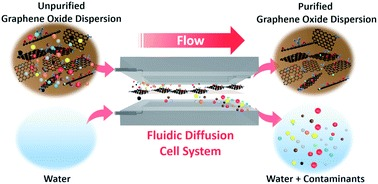
Source: Royal Society of Chemistry
Fig: Purification of Graphene Oxide Dispersion by using Fluidic Cell
How Graphene Oxide Dispersion Works in Water Treatment
Graphene oxide dispersion in water treatment can take various forms, each tailored to specific types of contamination. Here’s how graphene oxide can be utilized in several water treatment processes:
- Heavy Metal Removal
Heavy metals are toxic to both humans and the environment, and they are commonly found in industrial wastewater. Graphene oxide’s high surface area and functional groups make it an excellent material for adsorbing these metals. Studies have shown that GO can effectively remove lead, cadmium, and arsenic from water, offering a promising solution for industrial water treatment. - Oil and Organic Contaminant Removal
Graphene oxide’s hydrophilic nature enables it to interact with oil and organic pollutants in water. It can effectively trap these contaminants, making it useful for purifying water that has been contaminated with oils, dyes, or pharmaceuticals. GO-based filters can provide efficient solutions for treating wastewater from industries like textiles, petroleum, and pharmaceuticals. - Desalination
Desalination, the process of removing salt from seawater to make it drinkable, is one of the most exciting applications of graphene oxide in water treatment. GO-based membranes have shown great potential for desalinating seawater, as they are able to selectively allow water molecules to pass while blocking salts. This could revolutionize how we manage freshwater resources, particularly in arid or coastal
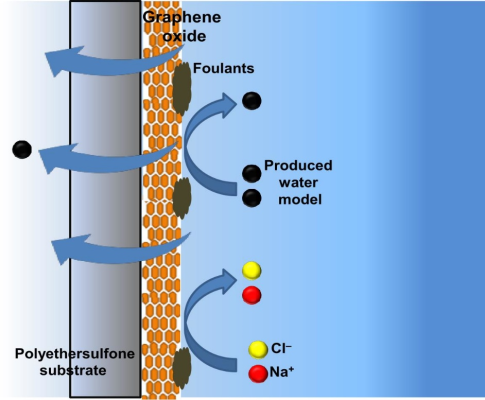
Source: https://www.mdpi.com/2077-0375/11/7/475
Fig: Illustration of rejection of chemicals and purification of water via the use of GO membrane pervaporation
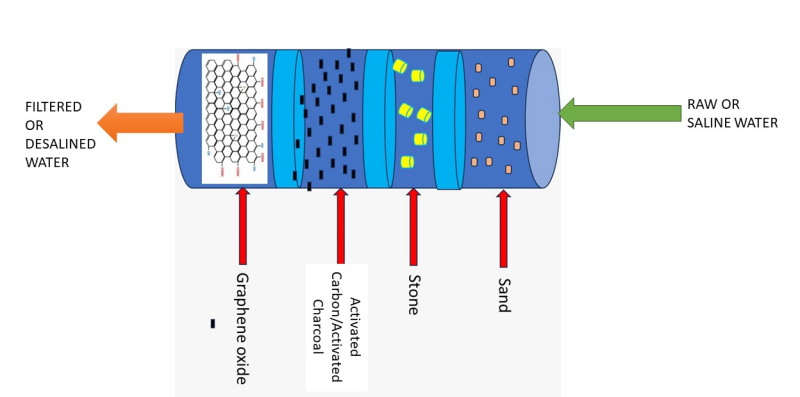 Fig: Water Filtration Scheme for Saline water
Fig: Water Filtration Scheme for Saline water
First few steps are the normal flow chart for any water filter to take out insoluble particles present in the water. The stack are successively Sand, pebble, Activated carbon etc. The last step is the removal of dissolved salt/ NaCl etc from the saline water. Graphene oxide powder can serve the purpose for removing soluble salt from the saline water.
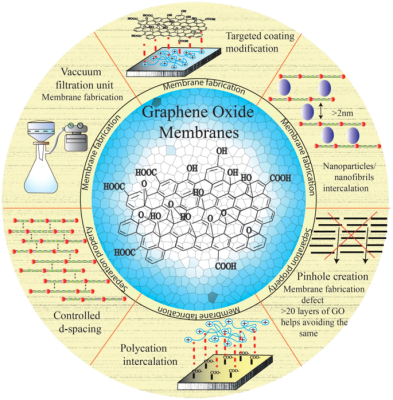
Fig: Mechanism of graphene oxide membrane-based separation
Challenges and Limitations
While graphene oxide shows immense potential for water treatment, there are still some challenges and limitations to address:
- Scalability: Although graphene oxide is relatively easy to produce in small quantities, scaling up production for large-scale water treatment applications remains a challenge. Finding ways to manufacture GO at lower costs and in large quantities will be key to its widespread adoption.
- Long-Term Stability: The long-term stability of graphene oxide dispersions in real-world water treatment applications needs further investigation. Factors such as pH, temperature, and the presence of other chemicals could potentially affect the performance and durability of GO-based systems.
- Environmental Impact: While graphene oxide is generally considered safe, the potential for it to enter natural water systems and affect aquatic life is still being studied. Further research is needed to ensure that GO does not pose a risk to the environment after use.
- Regulation and Standardization: As with any emerging technology, regulatory frameworks need to be developed to ensure the safe use of graphene oxide in water treatment. Standardization of GO production, quality control, and disposal will be critical to its success.
The Future of Graphene Oxide in Water Treatment
Graphene oxide-based water treatment systems hold great promise for addressing the growing global water crisis. As research progresses, graphene oxide may become an essential tool in providing clean, safe, and sustainable drinking water, especially in areas with scarce or contaminated water sources.
With its ability to remove heavy metals, oils, pathogens, and salts, graphene oxide dispersion is set to play a key role in the development of next-generation water purification technologies. If production methods are optimized and environmental concerns are addressed, GO could become an integral part of a global effort to tackle water pollution and ensure clean water access for all.
Conclusion
Graphene oxide dispersion represents a breakthrough in water treatment technology, offering a versatile and highly effective solution to some of the most challenging water quality issues. With its excellent adsorption properties, antibacterial effects, and the ability to remove a wide range of contaminants, graphene oxide could play a pivotal role in securing clean water for the future. As research continues and production methods improve, graphene oxide-based systems could become a cornerstone of sustainable water treatment practices worldwide.
Courtesy:
Moumita Maity
B.Tech Chemical Engineering
Sales & Service Engineer
Ultrananotech Private Limited , Bangalore
 +91-8800903073, 8452810712
+91-8800903073, 8452810712
